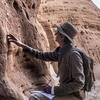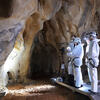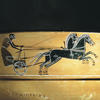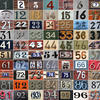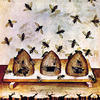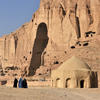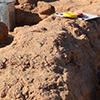You are here
Breathing life back into Antiquity

Golvin’s image-based reconstruction of archaeological sites1 is like a high-wire act, one that proceeds based on a scientific approach, but nevertheless does not aim to provide a totally exact depiction of a particular ancient landscape or painting. “I of course work closely with archaeologists, but my role is also to shake things up, to make them ask new questions, to have them imagine what may have been centuries and even millennia ago.” This involves so many conditionals and uncertainties that can unsettle the Cartesian reasoning of numerous researchers, and brought accusations of boasting for Golvin, whose meticulous draughtsmanship nevertheless reflects an unfailingly rigorous intellect.
For nearly 40 years, this architect, urban planner, and archaeologist has used his drawings and watercolours to introduce the general public to sites for which just a few enigmatic stones remain, offering little meaning to novices, even those most curious about ancient civilisations. A specialist on Roman amphitheatres, to which he devoted a doctoral thesis in 1985, Golvin initially “reconstructed” on paper an impressive number of cities from the Roman era, including Fréjus, Arles, Lutetia, Rome, and Syracuse, among others.

Portrait of Nîmes during the Roman era
One of his most important collaborative efforts began in 2010–with teams from the National Institute of Preventive Archaeological Research (Inrap) and the Heritage Development Department of the city of Nîmes–to depict Nemausus (Nîmes) during the late 1st century CE.
When the Inrap archaeologists Marc Célié and Richard Pellé show the map they based themselves on, it is initially difficult to believe. “Ruins and digs represent just 10% of the city’s surface,” explains Célié. “This is a far cry from the city of Pompeii, which is in an exceptional state of conservation. In Nîmes, the traces of the ancient city have all been covered by modern construction.” Nevertheless, twenty plates allow us to contemplate the city, its general layout, and situation within the landscape, as well as to see the most minute details of its outer walls, monuments, streets, and even homes!
How did Golvin achieve such a level of precision? In addition to his exchanges with archaeologists, the artist always uses numerous archives, including engravings, images, medals, travelogues, engraved glass flasks, and tapestries, among others. All of these sources are fragile and subject to caution: “For example, ancient images generally depict far fewer elements than actually existed on the original monument, and the colours are not reproduced. Or a particular element is deliberately blown up to emphasize its importance in relation to the whole.”
Living beings, human beings in particular, are also depicted, but on a scale that is always larger than the surrounding architecture. “Sometimes the images simultaneously represent the inside and outside of a building, doing so at the cost of spatial distortion, and in violation of the laws of perspective. While there are numerous sources of errors, reproduction is never invention. It is a proposal that grows out of logical reasoning, is founded on various indications, and is supplemented with arguments that build on one another.”
Célié recounts how the architect, thanks to his strong knowledge of the Roman world, compels researchers to think differently, to project themselves into a different space: “For Nîmes, as we went along, we were able to extend the beginnings of streets and have them connect, to place a particular monument at one location rather than another due to topography, to imagine a plaza or a right angle, to find intersections. We also reflected on how the overall network worked, proposing a function for each sector–craftsmen here, warehouses there–and then finally “plugging” all of the holes in this urban framework.”
An inevitably risky reconstruction
To reconstruct cities buried in history, all Golvin needs is a simple toolkit of pencils, ink, tracings, and paper, along with a blow dryer to dry his watercolours. He begins by drawing a perspective grid and then fills each square, with the drawing generally beginning in the foreground and moving toward the horizon. “We of course take risks, and are in the end presenting an image that is partly theoretical.”
Can we make do with a result that we know to be imprecise and perfectible, one that can potentially be challenged? “Nine times out of ten, when someone visits an archaeological site, they do not understand the ruins before their eyes. Even the maps we draw up after excavating are, for the most part, abstruse for the general public! This effort makes our research more accessible, on the condition that we are honest about the fact that a drawing represents our state of knowledge at a particular point in time, one that we know will ultimately change.”
And so ten years after the first representation of Nîmes during the Roman era, some motifs already require modification. “We had placed tiled roofs on the rampart towers, but when excavating one of the towers we found no tile fragments, even though many such fragments were found in the ruins of homes,” explains Célié. “These fragments could not have simply been blown away, so we concluded there were no roofs on the towers, and revisited our assumptions. That’s how science advances!”

This effort at reproduction is interesting for not only the public but also researchers, who are increasingly attempting not just to find monuments, but also to determine how they were constructed. The ongoing restoration of the amphitheatre in Nîmes, one of the best conserved from the Roman world, benefited from the questions asked by archaeologists during the creation of Golvin’s drawing.
With a seating capacity of approximately 24,000 spectators—and preserved almost entirely, with numerous original stands—the construction of this monument had remained a mystery. How did teams raise stone blocks weighing multiple tons 15 meters into the air, and how did they arrange them? Where did they start? “We took advantage of the reproduction to make proposals regarding construction techniques and tools. Drawings allow us to test various hypotheses,” points out Golvin.
During the exhibition the city devoted to the amphitheatre, it was shown how the workers went about raising this edifice within an already urbanised space, the neighbourhood where they set up the worksite for cutting stones, for producing mortar, where they put the dirt cleared away during levelling. “It is in working on the whole city and its overall organisation, its town planning, that we draw the interest of audiences that do not usually frequent archaeological museums, especially youngsters,” observes Célié. “That is when our profession assumes its full meaning.”
Recreating ways of doing
In a similar vein, in their book entitled Le génie maritime romain (Roman Maritime Engineering, Actes Sud, 2020), Golvin and the archaeologist Gérard Coulon took an interest in the construction methods used for port infrastructure, as well as the final result. “A central focus was to recreate the conditions of an ancient construction site, with its range of concrete and practical problems,” explains Coulon. They pursued every avenue in their effort to do so, such as this 2nd-century graffiti depicting a floating crane, which can reasonably be assumed was used to move heavy loads.

“We especially took advantage of results from a project led by an international research team (Romacons, for Roman Maritime Concrete Study Project), which took samples of concrete in order to ascertain how this material poured 2,000 years ago resisted for so long,” adds Coulon. They successfully identified its components (a combination of lime and sand from Pozzuoli, Italy), and determined the methods the Romans used to create the concrete’s formwork in a marine environment, one that is unstable, moving, subject to silting, and often to extreme weather as well.
Waterwheels, bucket chains, water screws, piston pumps: Golvin used these results to represent a number of tools and machines for which there are no archaeological traces. “I also worked with a French maritime engineer, Arthur de Graauw. His knowledge of modern port structures and his taste for Antiquity led him to devote most of his career to the study of ancient ports. He was able to confirm or disconfirm the possibility of building with a particular technique.”
For example, the immense port of Alexandria, which at the time was the second largest city in the Roman Empire, comes to life before our eyes with its huge jetty, its seven interconnected terminals (large port and various secondary ports), and its famous lighthouse. From this monument, for which no remains are visible (it collapsed in 1303 and disappeared beneath a fortress built on the location), he was able to create an image very close to reality, thanks to the accounts of various travellers, representations on coins, and the fact that a person of note had a reduced-scale model of the lighthouse built on his tomb!

Comic books for daily life in Antiquity
Golvin has increasingly engaged with the figures who lived in the cities and landscapes he recreates. For the exhibition Living and Dying in Egypt, which recently opened at the musée d’Aquitaine, he uses large panels to present a comic book of sorts depicting daily life in Faiyum during the Ptolemaic period (323-30 BCE). He set out from papyrus rolls written in ancient Egyptian or Greek known as cartonnage: obsolete administrative and private archives that the Egyptians subsequently used as decorative elements for mummified humans.
“Imagine that you recycle administrative archives, old tax registers, cost estimates, real estate deeds, and use them like scratch paper,” explains Marie-Pierre Chaufray, one of the exhibition’s curators, and an Egyptologist at the Institute for Research on Antiquity and the Middle Ages.2 “Egyptian embalmers glued them together to obtain a kind of papier mâché, which they covered with a layer of stucco, decorated, and then placed on mummies. Each year we decipher more of these documents, which provide a great deal of information regarding this territory and the local population: the number of people per family, their first names and ages, the amount of taxes paid, the land they farmed, their commercial activities, etc.”

Rather than presenting a “simple” translation of papyri in the museum, the exhibition curators asked Golvin to illustrate them. His scientific rigour, combined with his artistic freedom, allow us to visualise the life of a potter, a basket maker, or a fisherman; to imagine a Greek man complaining about being insulted and attacked by an Egyptian woman, who soiled his clothes by throwing a bucket of urine on him; to meet the animals that could be found in these villages, including monitor lizards, fish, herons, ibises, donkeys, and pack camels.

Golvin has already produced over 1,000 watercolours, a good portion of which can be viewed on his website, while others led to numerous publications. Why not use 3D images? The Virtual Map of Rome project,3 for instance, conducted for 10 years by the Interdisciplinary Centre for Virtual Reality at l’université de Caen, has demonstrated the interest, for both the public and experts, of translating research into CGI. “For me the two techniques are complementary,” says Golvin. “The primary interest of CGI is that it can be updated infinitely. However, drawn images are much faster to execute, cost less, and are less likely to be outmoded. Today I would not dare to display the computer generated images from 1990 recreating the Karnak Temple.”

Golvin’s diplomacy with researchers, who were very wary at first, has been rewarded: “They understood that this was fertile work, for both the public and themselves. In the end I would say that what I do is not just archaeology. I try to render a certain reality using signs that constitute a language.” A language that must be universal, for Golvin’s books have enjoyed growing success not only in Europe, but also in China and the United States.
More on Jean-Claude Golvin’s drawings
Jean-Claude Golvin’s website
Representations of Nîmes through the centuries
Watch
Promenade in Nemausus, animated film based on drawings by J.-C. Golvin, offering a reproduction of the ancient city during the 2nd century CE.
Exhibition Living and Dying in Egypt, 27 June-3 November 2024, Musée d’Aquitaine, Bordeaux.
Read
Jean-Claude Golvin et l’art de la restitution, eds. Jean-François Bernard and Alain Bouet, Ausonius Editions, 2023, 374 p.
Le génie maritime romain, Jean-Claude Golvin and Gérard Coulon, Actes Sud, 2020, 202 p.
- 1. CNRS Senior Researcher Emeritus, Ausonius Institute - Institute for Research on Antiquity and the Middle Ages (CNRS/Ministère de la culture/Université de Bordeaux Montaigne).
- 2. Ausonius Institute (CNRS/Ministère de la culture/Université de Bordeaux Montaigne).
- 3. Virtual Rome project: https://cireve.unicaen.fr/plan-de-rome-virtuel/























